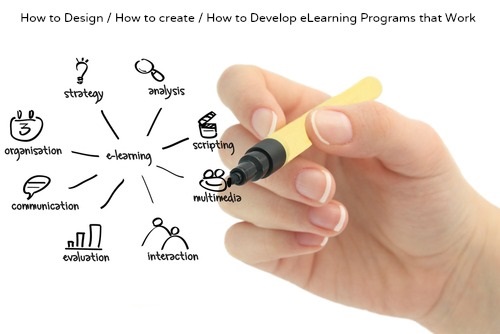How to Design, Create, Develop e-Learning Programs that Work
It has been predicted that the schools of the future have no walls. Peter Drucker, as well as other successful millionaire entrepreneurs predicted this years ago, before the internet became the center of all that it is today. But with the advent of online learning, it is a whole new world. So, while there are still thousands of brick and mortar schools which show no signs of shutting down, gradually the shift of learning is moving toward a virtual world environment where the chalkboard is replaced by a whiteboard, and the teacher is replaced with a software application.

Still, the instructor has been and will continue to be an integral and significant part of the educational process, whether the learning occurs between four walls, or in a virtual classroom.
The focus now is on how to design/how to create/how to develop e-Learning that works, so that institutions which were, in the past, only brick and mortar may compete with upstart online institutions, as well as continue to offer a variety of course offerings in the online world, which is growing daily to include a number of professional people who are seeking an education online.
So where should you start in planning your e-Learning program?
Here are some tips when developing a plan in how to design / how to create / how to develop e-Learning:
- Know your market. Just like in any sales or marketing situation, it is important to know who your market is and plan a program around this. If your student population consists of online learners in a public school who are utilizing distance learning, your approach will be much different than if you are catering to an older population who are continuing their education.
- Consider the curriculum based on standards. As much as possible, you will want to align your courses to complement the state standards of the areas in which you are offering the courses. You want the curriculum to follow industry standards also, so that it is more likely to be accredited, as this will build credibility for your course offerings.
- Put a system in place which will address all of the important bookkeeping issues, such as grading tests, online test practices, homework criteria, and more.
- Focus on accountability standards. Train instructors to follow best practices and recruit instructors from a variety of backgrounds which complement the courses you offer. Build credibility for your e-Learning system through professional staffing.
- Employ the use of multiple technologies to keep students engaged and learning. Just like in the real classroom, instructors and curriculum planning of eLearning platforms need to keep up with the trends of the new technologies so that you can offer students a variety of learning methods and styles to obtain the knowledge they are seeking and keep them interested in the coursework.
In addition to these tips on how to design/how to create/how to develop e-Learning programs, you will want to emphasize what the learner will achieve at the end of the course, what degree or certificate they will have to show for it, and how they will be able to use the knowledge they have obtained at the end of the requirements.
If you are in need of tools to pull your resources together and present an e-Learning program that takes the guesswork out of online instruction, contact us via our website or any of our social media sites: Facebook, Twitter, LinkedIn! We have the solution for your e-Learning program that will eliminate the need for trial and error and put the power of e-Learning distribution in your hands.
